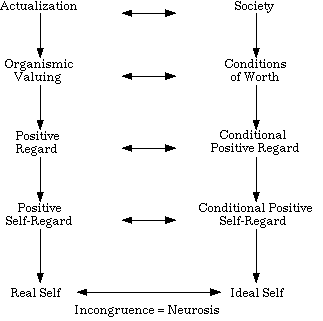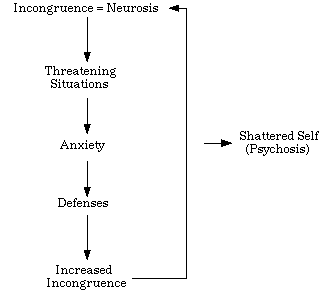LECTURE NOTES OF PERSON-CENTERED
THERAPY
D. Dutta Roy
Venue: Performing Arts Therapy Center, Rabindra Bharati University, Kolkata
INTRODUCTION
Person-centered
therapy (PCT) is also known as person-centered psychotherapy, person-centered
counseling, client-centered therapy and Rogerian psychotherapy. PCT is a form
of talk-psychotherapy developed by psychologist
Carl Rogers
in the 1940s and 1950s.

AIMS
The goal of PCT is to provide patients with an
opportunity to develop a sense of self wherein they can realize how their
attitudes, feelings and behavior are being negatively affected and make an
effort to find their true positive potential. In this technique,
therapists create a comfortable, non-judgmental environment
by demonstrating congruence (genuineness), empathy,
and unconditional positive regard toward their patients while using a
non-directive approach. This aids patients in finding their own solutions to
their problems. Rogers
believed that the most important factor in successful therapy is the
therapist's attitude. There are three interrelated attitudes on the part of the
therapist:
- Congruence -the willingness to relate to clients without hiding behind a professional facade.
- Unconditional Positive Regard - therapist accepting client for who he or she is without disapproving feelings, actions or characteristics. It shows the willingness to listen without interrupting, judging or giving advice.
- Empathy -Understand and appreciate the client's feeling throughout the therapy session.
Stages of Therapeutic Change:
The process of constructive personality change can be
placed on a continuum from most ‘defensive’ to most ‘integrated’. Rogers (1961) arbitrarily
divided this continuum into seven stages.
Stage 1
is characterized by an unwillingness to communicate anything about oneself.
People at this stage ordinarily do not seek help, but if for some reason they come
to therapy, they are extremely rigid and resistant to change. They do not
recognize any problems and refuse to own any personal feelings or emotions.
In Stage 2,
clients become slightly less rigid. They discuss external events and other
people, but they still disown or fail to recognize their own feelings. However,
they may talk about personal feelings as if such feelings were objective
phenomena.
As clients enter into Stage 3, they more freely talk about self, although
still as an object. “I’m doing the best I can at work, but my boss still
doesn’t like me.” Clients talk about feelings and emotions in the past or
future tense and avoid present feelings. They refuse to accept their emotions,
keep personal feelings at a distance from the here-and-now situation, only
vaguely perceive that they can make personal choices, and deny individual
responsibility for most of their decisions.
Clients in Stage
4 begin to talk of deep feelings but not ones presently felt. “I
was really burned up when my teacher accused me of cheating.” When clients do
express present feelings, they are usually surprised by this expression. They
deny or distort experiences, although they may have some dim recognition that
they are capable of feeling emotions in the present. They begin to question
some values that have been introjected from others, and they start to see the
incongruence between their perceived self and their organismic experience. They
accept more freedom and responsibility than they did in Stage 3 and begin to tentatively
allow themselves to become involved in a relationship with the therapist.
By the time clients reach Stage 5, they have begun to undergo significant change
and growth. They can express feelings in the present, although they have not yet
accurately symbolized those feelings. They are beginning to rely on an internal
locus of evaluation for their feelings and to make fresh and new discoveries
about themselves. They also experience a greater differentiation of feelings
and develop more appreciation for nuances among them. In addition, they begin
to make their own decisions and to accept responsibility for their choices.
People at Stage
6 experience dramatic growth and an irreversible movement toward
becoming fully functioning or self-actualizing. They freely allow into awareness
those experiences that they had previously denied or distorted. They become
more congruent and are able to match their present experiences with awareness
and with open expression. They no longer evaluate their own behavior from an
external viewpoint but rely on their organismic self as the criterion for
evaluating experiences. They begin to develop unconditional self-regard, which
means that they have a feeling of genuine caring and affection for the person
they are becoming. An interesting concomitant to this stage is a physiological
loosening. These people experience their whole organismic self, as their
muscles relax, tears flow, circulation improves, and physical symptoms
disappear. In many ways, Stage 6 signals an end to therapy. Indeed, if therapy
were to be terminated at this point, clients would still progress to the next
level.
Stage 7
can occur outside the therapeutic encounter, because growth at Stage 6
seems to be irreversible. Clients who reach Stage 7 become fully functioning
“persons of tomorrow” (a concept more fully explained in the section titled The
Person of Tomorrow). They are able to generalize their in-therapy experiences
to their world beyond therapy. They possess the confidence to be themselves at
all times, to own and to feel deeply the totality of their experiences, and to
live those experiences in the present. Their organismic self, now unified with
the self-concept, becomes the locus for evaluating their experiences. People at
Stage 7 receive pleasure in knowing that these evaluations are fluid and that
change and growth will continue. In addition, they become congruent, possess unconditional
positive self-regard, and are able to be loving and empathic toward others.
OUTCOME
The Person of Tomorrow
If
the three necessary and sufficient therapeutic conditions of congruence,
unconditional positive regard, and empathy are optimal, then what kind of
person would emerge? Rogers
(1961, 1962, and 1980) listed several possible characteristics.
First, psychologically healthy people would be more adaptable. Thus,
persons of tomorrow would not merely adjust to a static environment but would realize
that conformity and adjustment to a fixed condition have little long-term
survival value.
Second, persons of tomorrow would be open to their experiences, accurately
symbolizing them in awareness rather than denying or distorting them. This
simple statement is pregnant with meaning. For people who are open to
experience, all stimuli, whether stemming from within the organism or from the
external environment, are freely received by the self. Persons of tomorrow
would listen to themselves and hear their joy, anger, discouragement, fear, and
tenderness.
A related characteristic of persons of tomorrow would
be a trust in their organismic selves.
These fully functioning people would not depend on others for guidance because they would
realize that their own experiences are the best criteria for making choices; they would do what feels right for them
because they would trust their
own inner feelings more than the pontifications of parents or the rigid rules
of society. However, they
would also perceive clearly the rights and feelings of other people, which they would take
into consideration when making decisions.
A third characteristic of persons of tomorrow would
be a tendency to live fully in the
moment. Because these people would be open to their experiences,
they would experience a constant state of fluidity and change. What they
experience in each moment would
be new and unique, something never before experienced by their evolving self. They would see each
experience with a new freshness and appreciate it fully in the present moment.
Fourth, persons of tomorrow would remain confident of
their own ability to experience harmonious
relations with others. They would feel no need to be liked or loved
by everyone, because they would know that they are unconditionally prized and
accepted by someone. They would seek intimacy with another person who is probably
equally healthy, and such a relationship itself would contribute to the
continual growth of each partner. Persons of tomorrow would be authentic in
their relations with others. They would be what they appear to be, without
deceit or fraud, without defenses and facades, without hypocrisy and sham. They
would care about others, but in a nonjudgmental manner. They would seek meaning
beyond themselves and would yearn for the spiritual life and inner peace.
Fifth, persons of tomorrow would be more
integrated, more whole, with no artificial boundary between conscious
processes and unconscious ones. Because they would be able to accurately
symbolize all their experiences in awareness, they would see clearly the
difference between what is and what should be; because they would use their
organismic feelings as criteria for evaluating their experiences, they would
bridge the gap between their real self and their ideal self; because they would
have no need to defend their self-importance, they would present no facades to
other people; and because they would have confidence in who they are, they
could openly express whatever feelings they are experiencing.
Sixth, persons of tomorrow would have a basic trust of human nature. They
would not harm others merely for personal gain; they would care about others
and be ready to help when needed; they would experience anger but could be
trusted not to strike out unreasonably against others; they would feel
aggression but would channel it in appropriate directions.
Finally, because persons of tomorrow are open to all
their experiences, they would enjoy a greater
richness in life than do other people. They would neither
distort internal stimuli nor buffer their emotions. Consequently, they would
feel more deeply than others. They would live in the present and thus
participate more richly in the ongoing moment.
Source: life sketch
Source: life sketch


